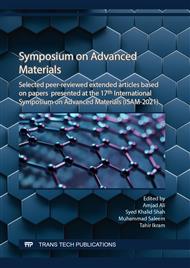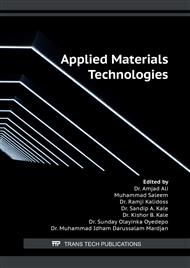p.139
p.145
p.153
p.163
p.177
p.183
p.191
p.199
p.207
Development of 2nd Generation Thin Film Photovoltaics Based on CZTS Absorber Layer and ZnS Window Layer
Abstract:
Among the second-generation solar cells, thin-film solar cells based on CIGS, CZTS and CdTe are well known due to their higher efficiencies, low cost and simple fabrication techniques. In this proposed work, we are committed to developing CZTS and ZnS thin films for second-generation thin-film photovoltaics. CZTS and ZnS have energy band gap of 1.4-1.5 eV and 3.6 eV, while their light absorption coefficients are 104 cm-1 and 3.3×104 cm-1 respectively. In thin film solar cells, absorber layer consists of photovoltaic material that should have optimal bandgap close to 1.34 eV. Moreover, a wide band gap window layer acts as p-n junction with absorber layer. In this work, we are reporting the synthesis of CZTS and ZnS thin films via wet chemistry route using spin coating method. Deposition of thin films on SLG substrate were carried out at specific process parameters such as spinning speed, concentration of precursors and annealing temperature to get the optimized thin film suitable for photovoltaic applications. Surface morphology and elemental compositional analysis investigated through SEM and EDX spectroscopy respectively. Electrical and optical properties were examined via Hall effect measurements and UV-VIS NIR spectrophotometry respectively. In addition micro-chemical and functional group analysis were conducted by FRIT spectroscopy. Keywords: Thin film PV, wet-chemistry, CZTS, ZnS
Info:
Periodical:
Pages:
177-182
Citation:
Online since:
August 2022
Authors:
Keywords:
Price:
Сopyright:
© 2022 Trans Tech Publications Ltd. All Rights Reserved
Share:
Citation:



